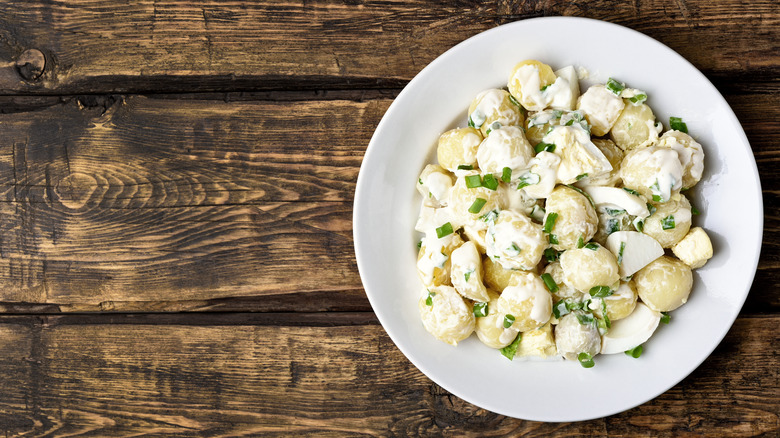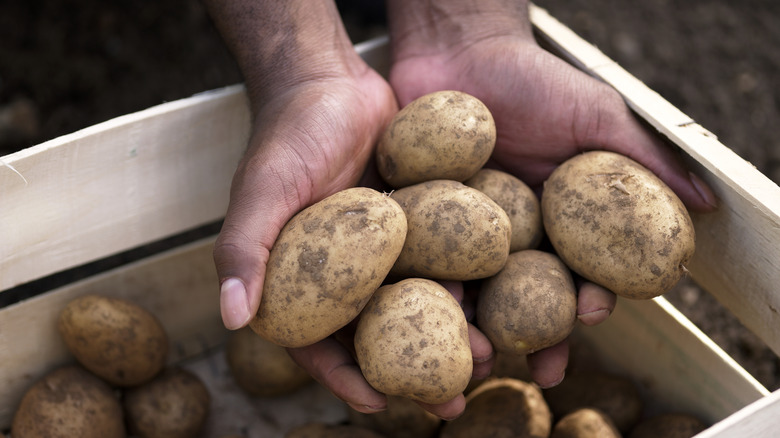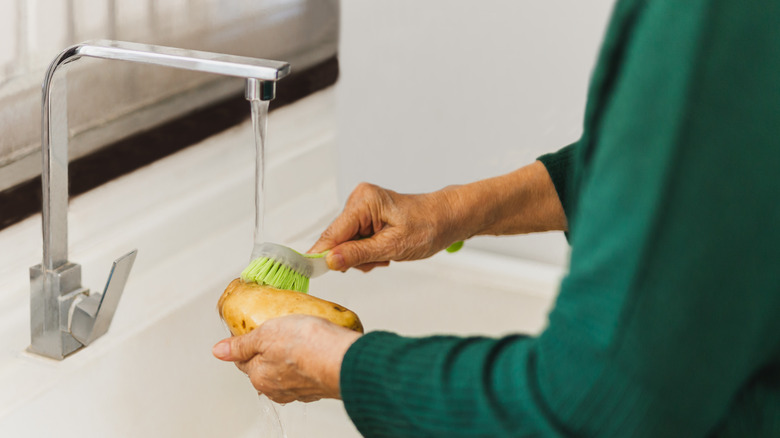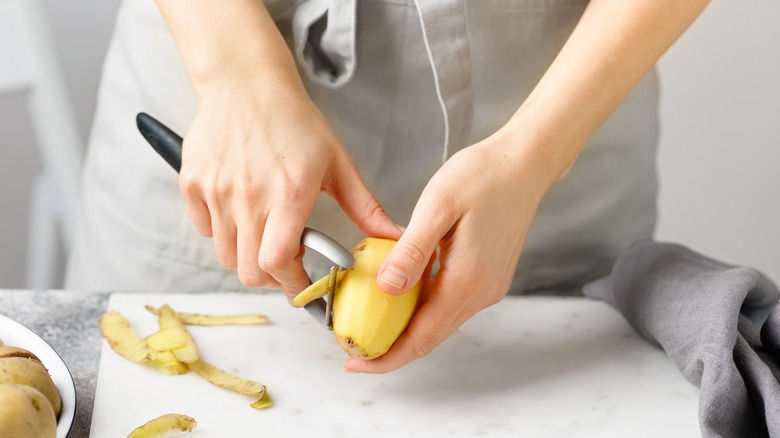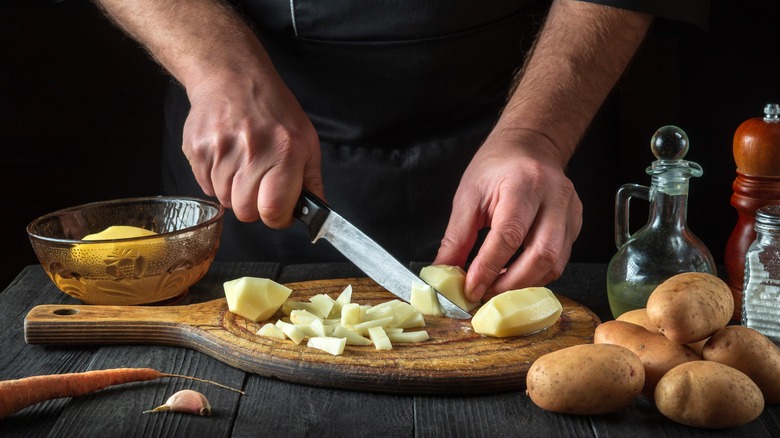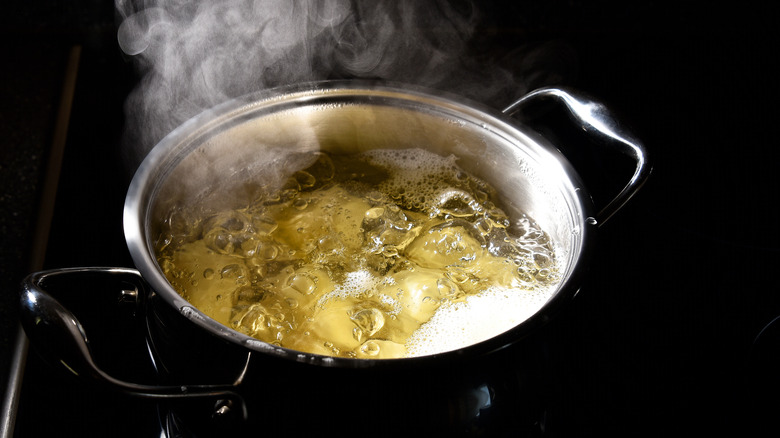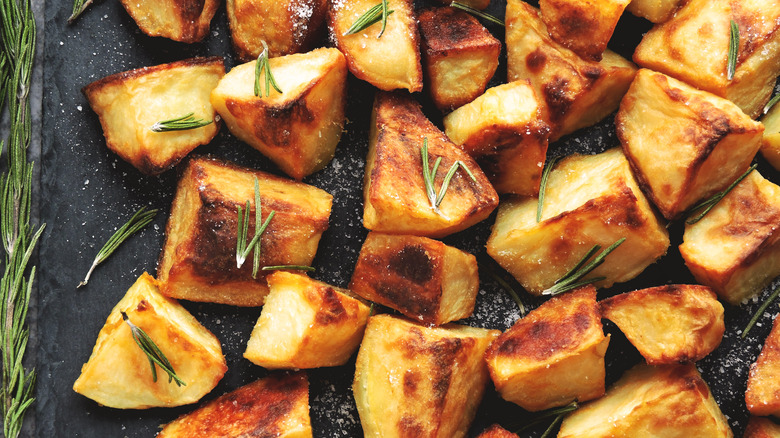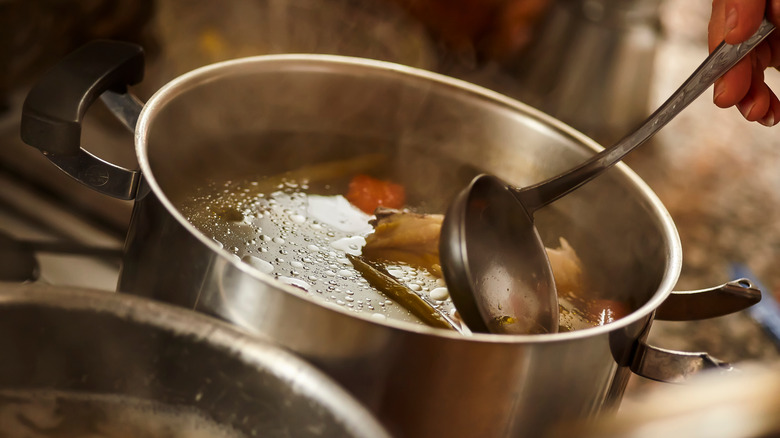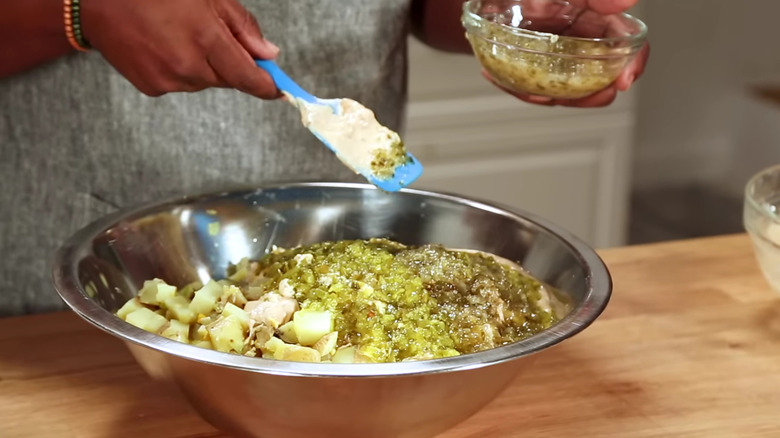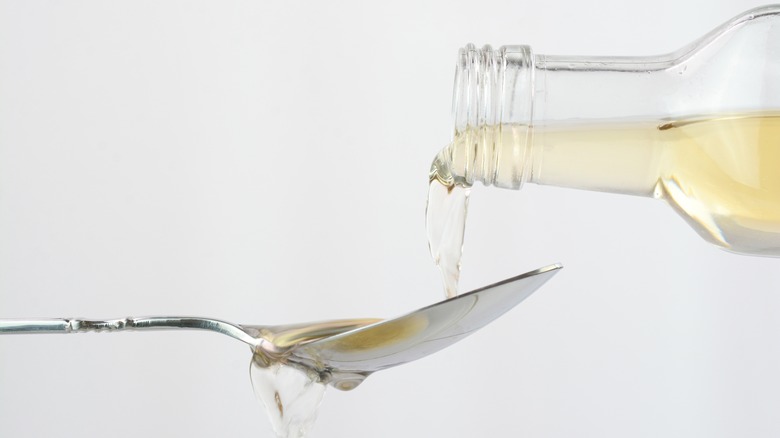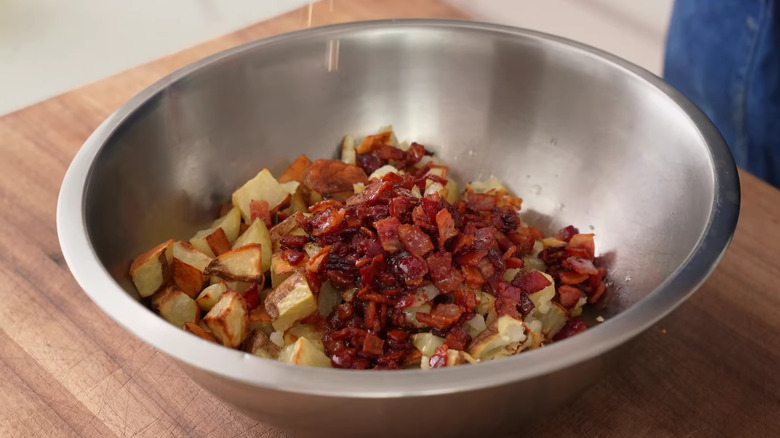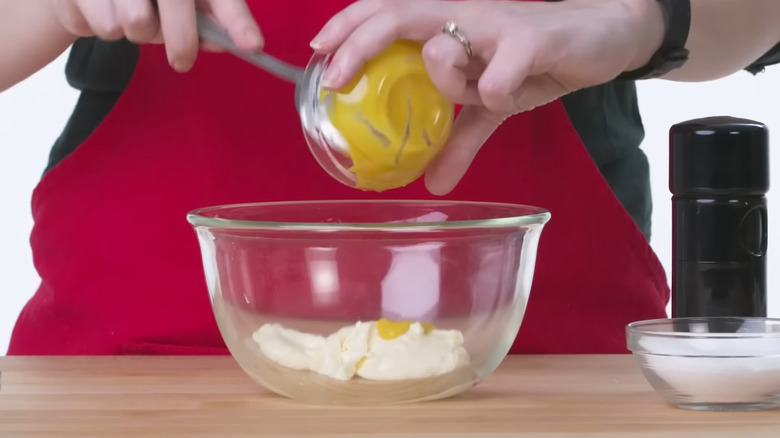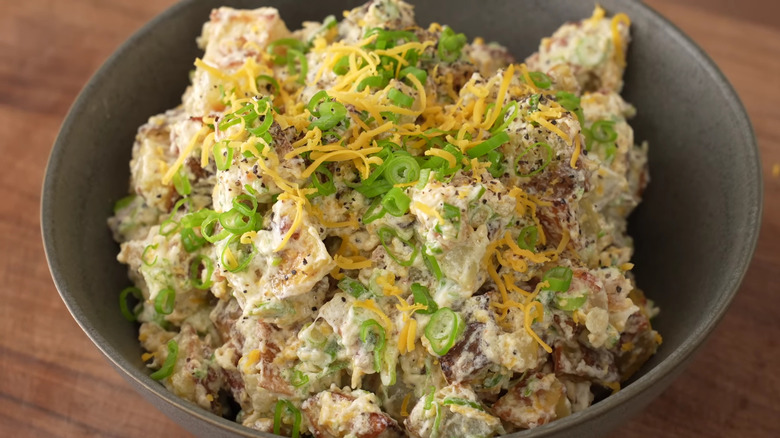The 12 Biggest Mistakes You Might Be Making With Potato Salad
Potato salad was brought to the United States by German immigrants during the 19th century. Today, it is perhaps the most popular and varied side dish in the country. Regularly spotted at cookouts, it seems like every family has their own jealously guarded recipe, complete with secret ingredients that range from spice mixes to raisins.
While potato salad recipes vary from family to family, nearly all of them share some universal features. Of course, the first is that they all contain potatoes. Other assumptions are that the salad includes the presence of a dressing and a few added ingredients. These shared features ensure that, despite stylistic discrepancies, there are some universal mistakes made by home cooks when making potato salad. In this article we cover 12 of the most prevalent. Remedying these common mistakes will improve the final quality of your potato salad dramatically, regardless of the recipe you are following.
1. Using the wrong type of potatoes
The first potential slip up is selecting the wrong type of potatoes. With over 500 variates of this tuber grown internationally, your options are almost endless. Some swear by red potatoes, others by Charlotte. In the end, however, it all boils down to what type of potato salad you are trying to create.
For classic, European style potato salad it is generally accepted that waxy varieties, as opposed to floury, are superior. This is because waxy variants, like new potatoes and Red Bliss, maintain their shape during cooking, resulting in the firm textures associated with this version of the dish. Private chef Christina Bailey highlights why this is, saying "Waxy potatoes absorb less water during boiling. This helps them hold their shape." (via Insider).
On the other hand, some variations on potato salad adopt more of a creamy texture than a firm one. In these instances floury potatoes such as Maris Piper and Red Baron are preferred. These tend to break down more during boiling, lending the dish a softer consistency.
2. You're not cleaning potatoes properly
Regardless of which variety of potato you choose, it is vital that they are properly cleaned before cooking. Former chef Catt Fields White explained why cleaning potatoes is important to Martha Stewart saying, "Potatoes are firmly in the buried-in-soil category, so they'll need a thorough wash before cooking. In addition to good and bad bacterias, pesticides can linger in the soil and those need to go."
The correct method for washing potatoes, as specified by the Food and Drug Administration, involves washing your hands, rinsing the potatoes, and then using a vegetable brush or scourer to scrub them. When done correctly, these steps should remove all ingrained dirt as well as traces of pesticides. It is important to note that potatoes should always be washed before being peeled to prevent contamination. As the act of scrubbing may remove some of the skin it is advised that potatoes should be washed just before use. This minimizes spoilage.
3. Peeling the potatoes
While personal preference will undoubtedly influence whether you peel your potatoes or not, from a nutritional perspective there is only one choice: Leave the potatoes unpeeled. Potato skins harbor a great deal of nutrients. A fact underscored by Simon Moltoni, chief executive of WA Potatoes. "From a health point of view, and I think from a taste and texture point of view, it's much better to leave the skin on. The skin of the potato is very high in fiber, potassium, Vitamin C, Vitamin B — all of those good, healthy things are in high concentration in the skin," (via ABC).
As potato skins disrupt the smooth texture of soft boiled potatoes, recipes for creamier variations of potato salad may call for the potatoes to be peeled. This is absolutely fine, but home cooks should be aware that they are passing up on a great deal of nutrients and a wholesome, slightly earthy, taste by doing so.
4. Cutting uneven pieces
Knife skills are seen as one of the fundamental building blocks of cooking. They allow you to safely and effectively break down ingredients to facilitate the cooking process. Unfortunately, poor knife skills result in food that is cut into varying sizes. No matter what cooking method is used, this will lead to inconsistent cooking. The smaller pieces will cook faster than the larger pieces which will result, in this instance, with some pieces of potato being either under or overcooked.
Mastering knife skills takes practice but there are some quick tips to gain further control over your knife. The most prominent of these is holding the knife correctly. You should not wrap your entire hand around the handle. Instead, adopt the position explained by chef Herve Malivert. "Having correct hand positioning on the knife is essential," Malivert said. "to grip the knife properly, put your middle, ring, and pinky fingers around the handle, and grip the blade with your index finger and thumb. Then, to correctly chop, hold the item with one hand and then keep the tip of your knife on your board and with the other move up and down," (via Well and Good).
Another simple tip is to ensure your knife is always sharp. Having a keen edge will mean less pressure needs to be applied during the cutting process. This will lend your cuts greater precision, and thus more even end results.
5. Adding your potatoes to boiling water
It seems like second nature to wait for the water to boil before adding your food. After all, it is the common practice for popular ingredients like pasta. One of the few exceptions to this rule is the potato. These tubers should always be started off in cold water. Heating up the water and the potatoes together ensures that the outside of the potato does not cook quicker than the inside. Ultimately this leads to a more uniform texture developing. Floury potatoes will benefit most from this technique as they suffer from both inconsistent cooking and the associated water-logging to a much greater degree than their waxy counterparts.
Even once the water has reached a high temperature it's important not to let it boil. A simmer results in more even cooking as chef Kevin McAllister highlights. "I see a lot of people boil potatoes at a full boil," McAllister noted. "Yes, it will cook them faster, but this is where you get the outside over cooked and the center of the potato still raw," (via Cooking Light).
6. Believing that boiling is your only option
Boiling is the traditional method when making potato salad. Yet, it is not the only option available. Other cooking methods, including grilling, which transforms the nature of the dish by changing the potatoes texture and, to a lesser degree, their flavor.
By altering the flavor and texture of the salad's main ingredient, you also create new opportunities for flavor combinations, as chef Nicole Gajadhar revealed to Forbes. "Usually grilled meats are served with chimichurri, but here the potatoes are grilled until their sugars are caramelized, leaving them with a beautiful meat-like smokiness to accompany the zesty herby condiment."
Apart from grilling, potatoes react well to most cooking processes. Roasting will result in a crisp texture and moreish flavor. Similar results, although with less oil, can be achieved through air frying. You could even experiment with deep frying, transforming your potatoes into something akin to french fries.
7. Only cooking your potatoes in water
Cooking the potatoes is a golden opportunity to impart some extra flavor into the salad. This can be achieved through something as simple as salting the water sufficiently. Of course, there are some cooks who take it a bit further. Michelin starred chef Curtis Stone is one such cook. As well as boiling his potatoes in salted water, Stone likes to finish by simmering them in chicken stock, per Insider.
The advantage of this method is that the potatoes absorb the flavor of the stock, adding an extra dimension to the overall dish. These flavors are much more subtle than if their constituting ingredients were added to the salad. What's more, the lack of a discernible reason for flavors like chicken can make the dish intriguing.
Interestingly enough, the use of stock need not be limited to boiling alone. Roasting your potatoes in a bit of stock will have a similarly flavorful impact but with the added distinction of a crisp texture. An example of potatoes cooked via this method is the classic French dish, pommes boulangère. In this dish sliced potatoes are cooked in a stock on a low temperature. This has the effect of drawing the flavorful stock into the lower portion of sliced potatoes while those on the top develop a nice crispness; a moreish combination of texture and flavor that would be well-suited to potato salads.
8. Adding the dressing too early or too late
However the potatoes are cooked, it is vital that any oil-based dressings, such as a vinaigrette, are added while the potatoes are still hot. At this temperature the potatoes draw in the flavors of the vinaigrette. If added when cold, the majority of the dressing will run straight off the potatoes, gathering in the bottom of the salad bowl, leaving your salad bland.
Interestingly, the opposite is true for mayonnaise-based dressings. These should only be added once the potatoes have cooled as any temperatures over 90 degrees Fahrenheit can cause mayonnaise to split. This will negatively affect the mayonnaise's appearance and taste.
Furthermore, the dressing should be added to the potatoes alone. Other add-ins should be included at a later stage. This helps minimize the risk of over mixing as chef RJ Harvey highlighted to Southern Kitchen. "The last thing you want is to add all of your ingredients together into your potatoes and then try to mix everything," Harvey explained. "That's going to result in you over mixing your potato salad, which is going to end up too gloopy and soupy."
9. Forgetting to add acid
It's no secret that mayonnaise-based potato salads are incredibly creamy. This is one of their biggest attractions. However, an unbalanced, mayonnaise-rich potato salad can quickly become cloying, one dimensional, and bland. To prevent this from happening you must include some acidic ingredients to cut through all that fat.
What ingredient you use is entirely up to you. RJ Harvey likes to use pickle juice, which he adds when the potatoes are still warm, as you would with an acidic dressing. "So that pickle juice that goes on top of your potatoes is seeping into the inside of the potato, giving them more flavor," Harvey opined. "And that way when you go to bite into that potato salad, you're left with something that's just really, really flavorful," (via Southern Kitchen).
Of course, pickle juice is just one option. Vinegar is a simple addition that will have a similar effect, as is mustard. It is important to remember that acidic ingredients need only be added to mayonnaise-based potato salads. Thanks to the style of dressing, vinaigrette-based potato salads will already be sufficiently acidic.
10. Not adding extra ingredients
Extra ingredients, or add-ins, are where cooks can really stamp their mark on potato salad. This is an opportunity that should be taken. Potato salads are incredibly versatile and many add-ins are thus suitable. For example, Jason Goldstein, a recipe developer, likes to use avocados. "The creamy citrusy avocado hugs the starchy salty potato for this epic side dish," Goldstein noted. "I am obsessed with potato salad, and the avocado cream adds a fun twist to this summer staple. It's like guacamole and potato salad got married." (via Forbes). Other extras range from bell peppers to chips.
There is no "correct” add-in, though. Location, personal preference, and the other aspects of your potato salad will ultimately influence what ingredients you choose. Experimentation should also be encouraged. After all, it is the add-ins which come to define family recipes, for better of for worse. With this in mind it is important to be aware that everyone might not be as enthusiastic about your chosen extras as you are. After all, family recipes can seem bizarre to those outside our inner circle.
11. Rejecting Mustard
There are many types of mustard, including sharp, yellow, English mustard, and the well-balanced wholegrain. Nearly all styles of mustard are a fantastic addition to potato salad, with their acidic nature being well suited to forming part of a vinaigrette. As we have seen, they can also be used as an extra ingredient to cut through fatty, mayonnaise-based dressings.
Mustard's acidity is complemented by other acidic ingredients. Chef Shenarri Freeman gave one example of a three-way acidic combination when talking to Forbes: "The secret ingredient is Dijon mustard, which gives it the right amount of tang, evened out with the lemon juice," she explained. "The pickles are a personal preference to replace the relish. This potato salad is best enjoyed in the spring and summer and an easy way to cool off from the warm weather."
Furthermore, a study published in The Ethnopharmacological Investigation of Indian Spices found that mustard seeds are packed full of nutrients and antioxidants. As such, consuming mustard has numerous health benefits including both antibacterial and antimicrobial properties, making the inclusion of mustard an easy way to boost the healthiness of your salad.
12. Failing to create textural contrasts
Unless attention is paid to additional ingredients, potato salads can easily adopt a homogenous soft texture. This should be avoided at all costs. Textural contrasts, created in this instance by the addition of crisp ingredients, are absolutely vital for the dish. This is because textural contrasts are one of the main ways that food sparks and maintains our interest.
Crisp foods are also highly thought of in their own right, for reasons anthropologist John S. Allen explained to MyRecipes. "One reason why crispy foods might be appealing on a more personal level is that crispy/crunchy adds a whole new sensory quality to a food, beyond taste. When we eat a lot of one food, there is a tendency to habituate to its flavor, making it less and less palatable as we consume it. With a crunchy food, the sensory experience encompasses sound as well as taste." Consequently, crisp ingredients are a vital addition to every potato salad.
There are many ways you can create textural contrast in potato salad. Adding croutons, raw vegetables, like radishes, or even chips will do the job. Equally, roasting or frying the potatoes will immediately make the potato salad crisp. Just be sure to add some soft, creamy ingredients — like mayonnaise — if you choose this latter approach.
